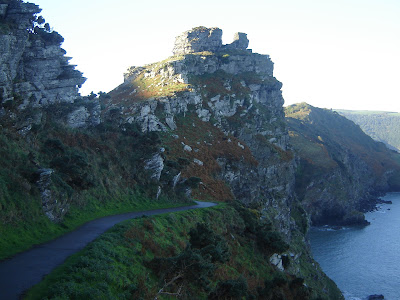In October 2016 I traveled to England for 17 days. My main goal was to solo hike an 80-mile section of the Southwest Coast Path (SWCP) which follows the coastline of Somerset and Devon, crossing through Exmoor. Following the hike I visited several different cities and villages throughout England, some of which I wanted to return to and others which were new to me. As usual, whenever I visit the UK, I traveled by train, using a Britrail Flexipass. Along the way I met some old friends. When I arrived at Heathrow airport I traveled to Redhill and checked into a B & B for 2 nights. The next day I traveled South to Brighton, one of England's premier seaside resorts, and spent the day exploring.
 |
| Brighton Pier |
 |
| Royal Pavilion in Brighton |
Returning to Redhill, I joined English friends Annie, Andy, Toni, and Dee at the Plough Pub for Quiz Night. A good time was had by all. The following day I boarded the train and traveled to Minehead, where my hike was set to begin. The SWCP is 630 miles long and is Britain's longest national trail. In the past I have hiked sections of the path in Devon, Cornwall and elsewhere, but I had never hiked the very beginning of the trail, which begins at Minehead and then goes South following the North Devon coastline. My seven day solo hike was exhilarating but quite challenging and strenous at times. Here are some photo's of what I saw and experienced during my hike on the SWCP from Minehead to Instow.
 |
SWCP, looking north from Hurlstone Point
|
 |
SWCP leading to the village of Bossington
|
 |
| Hurlstone Point |
 |
| Tea shop in Bossington |
 |
Cream Tea
After my first day of hiking, an easy 9 miles, I spent the night in the attractive village of Porlock. |
 |
Main Street in Porlock
|
 |
| Porlock |
Leaving Porlock the next day, I hiked to Porlock Weir and then entered Culbone Woods. Leaving the woods I followed the coast path signs and the landmark wild boar gatepost, and headed towards the village of Lynton.
 |
Approaching Porlock Weir
|
 |
Wild boar gate post on the path
|
 |
| Coast Path sign |
Day 3 proved to be the most scenically dramatic and physically challenging, a 14 mile test of endurance that first went through the mysterious landscape of the Valley of Rocks, followed by a stretch of beautiful coastline, then a descent into Heddon, one of the steepest valleys in England, then the ascent back out of the valley and up to the coastal cliffs, and then finally an ascent up to the top of Great Hangman the highest point on the SWCP and located on Britain's highest sea cliff. The weather cooperated on my hike, with only a few brief showers and frequent sunny spells. This made for enjoyable hiking and allowed me to better enjoy some of Southwest England's most dramatic and beautiful coastal landscapes. When I finally arrived at my B & B in Combe Martin my feet were protesting and my thighs were burning.
 |
| Castle Rock, in the Valley of Rocks |
 |
| Woody Bay |
 |
| Climbing out of the deep Heddon Valley |
 |
| SWCP |
 |
| Approaching Great Hangman |
 |
| By the cairn at the top of Great Hangman |
 |
| The descent down to the village of Combe Martin |
 |
| Watermouth Bay |
 |
| Approaching Ilfracombe on Day 4 |
On Day 5, hiking from Infracombe to Woolacombe, I encountered gorgeous coastal scenery.
 |
| Croyde Beach, on Day 6 of the hike |
 |
| Heading to the village of Braunton, Day 6 |
 |
| Taw Estuary on Day 7, the last day of the hike |
 |
Harbor at Instow, looking towards the village of Appledore
When my hike was over, I joined my friend Clive and his sister Lindy and husband Richard for an evening meal at a pub called the Beaver Inn in Appledore. The following day, using my railpass, I set out to explore other places in England. |
 |
| York Minster in York |
 |
| Queen Street in Biddeford |
 |
| Ruins of St Mary's Abbey, York |
 |
| Kings Manor in York |
One of the best half-timbered buildings in York, 1480
 |
| Durham Cathedral, one of the finest examples of Norman architecture in all of England |
 |
| The home of the Bronte's in the village of Haworth |
 |
| Statue of the 3 gifted Bronte sisters, Charlotte, Emily, and Ann, in the garden of the Bronte house |
 |
| Haworth Church graveyard. Most of the Bronte's are buried in a vault beneath the church |
 |
| Haworth |
 |
Bridge of Sighs in Oxford
On my last day in Oxford, I spent several hours at the Natural History Museum (which is free, unlike most other Oxford attractions), where I saw a very impressive collection of dinosaur skeletons, a block of orbicular granite 2.7 billion years old, and the room where the historic debate occurred between Thomas Huxley, Darwin's "bulldog" and staunch friend and defender, and the Bishop Samuel Wilberforce. The debate happened one year after the publication of Origin of Species by Charles Darwin, one of the most significant books ever written. |
 |
| Granite block in the Museum |
 |
| Stele outside Natl. History Museum, Oxford |
 |
| Natural History Museum, Oxford |
 |
| Plaque outside door to the room where the famous Huxley-Wilberforce debated occurred in 1860 |





